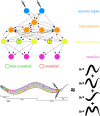Caenorhabditis elegans and the network control framework-FAQs
- PMID: 30201837
- PMCID: PMC6158218
- DOI: 10.1098/rstb.2017.0372
Caenorhabditis elegans and the network control framework-FAQs
Abstract
Control is essential to the functioning of any neural system. Indeed, under healthy conditions the brain must be able to continuously maintain a tight functional control between the system's inputs and outputs. One may therefore hypothesize that the brain's wiring is predetermined by the need to maintain control across multiple scales, maintaining the stability of key internal variables, and producing behaviour in response to environmental cues. Recent advances in network control have offered a powerful mathematical framework to explore the structure-function relationship in complex biological, social and technological networks, and are beginning to yield important and precise insights on neuronal systems. The network control paradigm promises a predictive, quantitative framework to unite the distinct datasets necessary to fully describe a nervous system, and provide mechanistic explanations for the observed structure and function relationships. Here, we provide a thorough review of the network control framework as applied to Caenorhabditis elegans (Yan et al. 2017 Nature550, 519-523. (doi:10.1038/nature24056)), in the style of Frequently Asked Questions. We present the theoretical, computational and experimental aspects of network control, and discuss its current capabilities and limitations, together with the next likely advances and improvements. We further present the Python code to enable exploration of control principles in a manner specific to this prototypical organism.This article is part of a discussion meeting issue 'Connectome to behaviour: modelling C. elegans at cellular resolution'.
Keywords: C. elegans; connectome; control theory; locomotion; network science.
© 2018 The Author(s).
Conflict of interest statement
We have no competing interests.
Figures





Similar articles
-
Network control principles predict neuron function in the Caenorhabditis elegans connectome.Nature. 2017 Oct 26;550(7677):519-523. doi: 10.1038/nature24056. Epub 2017 Oct 18. Nature. 2017. PMID: 29045391 Free PMC article.
-
Functional connectomics from neural dynamics: probabilistic graphical models for neuronal network of Caenorhabditis elegans.Philos Trans R Soc Lond B Biol Sci. 2018 Sep 10;373(1758):20170377. doi: 10.1098/rstb.2017.0377. Philos Trans R Soc Lond B Biol Sci. 2018. PMID: 30201841 Free PMC article.
-
Connectome to behaviour: modelling Caenorhabditis elegans at cellular resolution.Philos Trans R Soc Lond B Biol Sci. 2018 Sep 10;373(1758):20170366. doi: 10.1098/rstb.2017.0366. Philos Trans R Soc Lond B Biol Sci. 2018. PMID: 30201832 Free PMC article.
-
Sensorimotor integration in Caenorhabditis elegans: a reappraisal towards dynamic and distributed computations.Philos Trans R Soc Lond B Biol Sci. 2018 Sep 10;373(1758):20170371. doi: 10.1098/rstb.2017.0371. Philos Trans R Soc Lond B Biol Sci. 2018. PMID: 30201836 Free PMC article. Review.
-
Caenorhabditis elegans excitatory ventral cord motor neurons derive rhythm for body undulation.Philos Trans R Soc Lond B Biol Sci. 2018 Sep 10;373(1758):20170370. doi: 10.1098/rstb.2017.0370. Philos Trans R Soc Lond B Biol Sci. 2018. PMID: 30201835 Free PMC article. Review.
Cited by
-
Semantic Representation of Neural Circuit Knowledge in Caenorhabditis elegans.bioRxiv [Preprint]. 2023 Sep 26:2023.04.28.538760. doi: 10.1101/2023.04.28.538760. bioRxiv. 2023. Update in: Brain Inform. 2023 Nov 10;10(1):30. doi: 10.1186/s40708-023-00208-5. PMID: 37162850 Free PMC article. Updated. Preprint.
-
The expanding horizons of network neuroscience: From description to prediction and control.Neuroimage. 2022 Sep;258:119250. doi: 10.1016/j.neuroimage.2022.119250. Epub 2022 Jun 1. Neuroimage. 2022. PMID: 35659996 Free PMC article. Review.
-
A practical guide to methodological considerations in the controllability of structural brain networks.J Neural Eng. 2020 Apr 9;17(2):026031. doi: 10.1088/1741-2552/ab6e8b. J Neural Eng. 2020. PMID: 31968320 Free PMC article.
-
Network controllability mediates the relationship between rigid structure and flexible dynamics.Netw Neurosci. 2022 Feb 1;6(1):275-297. doi: 10.1162/netn_a_00225. eCollection 2022 Feb. Netw Neurosci. 2022. PMID: 36605890 Free PMC article.
-
Network structure of cascading neural systems predicts stimulus propagation and recovery.J Neural Eng. 2020 Nov 4;17(5):056045. doi: 10.1088/1741-2552/abbff1. J Neural Eng. 2020. PMID: 33036007 Free PMC article.
References
Publication types
MeSH terms
Grants and funding
LinkOut - more resources
Full Text Sources
Other Literature Sources

